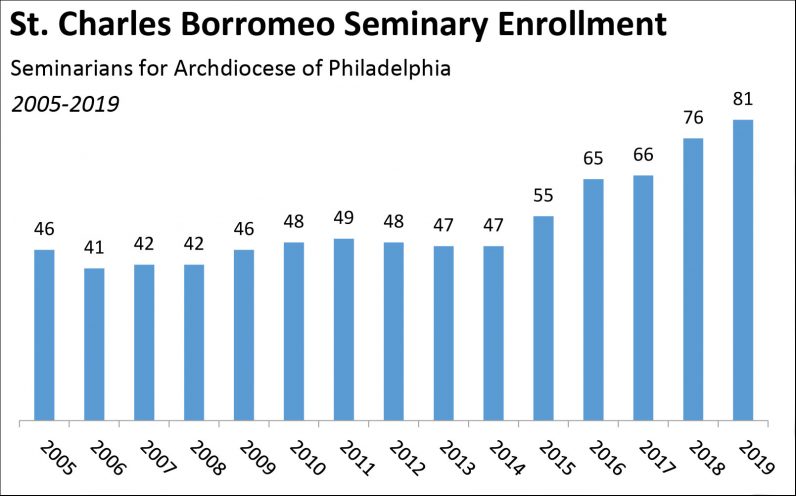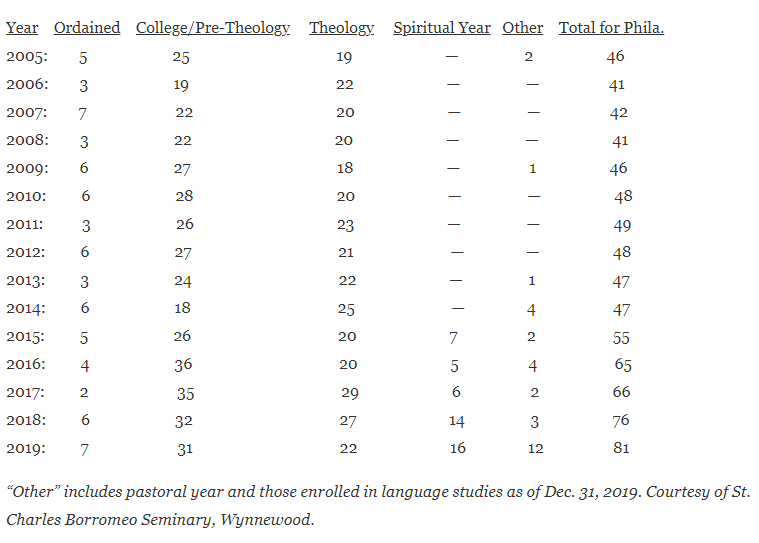
Figures include seminarians in college, pre-theology, theology, spiritual year, pastoral year and those enrolled in language studies as of Dec. 31, 2019. Courtesy of St. Charles Borromeo Seminary, Wynnewood.
Looking at Catholic statistics in the United States and the Philadelphia Archdiocese, there are many worrisome elements. Mass attendance, baptisms, numbers of schools and parishes — are all down. Is anything on the upswing?
Yes. Take a look at St. Charles Borromeo Seminary, where future priests for the Archdiocese of Philadelphia are formed, as well as priests for a number of other dioceses and religious congregations.
As it plans a future move to a smaller and more efficient campus, the seminary finds its enrollment numbers are increasing — a trend that has been growing for five years.
[hotblock]
The number of men studying for the Philadelphia Archdiocese bottomed out at 41 in 2006, the lowest in well over a century. But enrollment for Philadelphians stood at 81 at the beginning of the 2019-20 academic year.
That includes 16 seminarians deepening their prayer life in the seminary’s spiritual year, not actually on the Wynnewood campus but living at St. Matthew Parish, Conshohocken.
The enrollment number includes men with the Neo-Catechumenal Way, a Catholic movement whose seminarians studying at St. Charles will serve in the archdiocese after their ordination. The figure does not include men studying at St. Charles for about 15 other dioceses and religious orders.
It’s likely not all of these 81 men studying for Philadelphia will ultimately be ordained priests. Seminary formation a long journey of varying duration, and some will discern that God is not calling them to the priesthood. In some cases the seminary itself might make that decision for them.
But at the end of the day the increased enrollment should over time lead to more ordinations.
“I think we are certainly holding our own, but it is certainly not about numbers,” said Bishop Timothy Senior, the rector of St. Charles Seminary. “We want to make sure the program is doing its job. It is the quality of the program we are most proud of.”
[tower]
He cited the necessity of seminarians’ development in all four dimensions of priestly formation including academic, pastoral, human and spiritual formation. “You can have the best grades in the world but if you don’t have the spiritual life and the pastoral skills and the human qualities, you can’t be a priest,” Bishop Senior said.
One of the reasons St. Charles has been able to retain as many seminarians as it does until ordination is its ability to change with the times, according to the rector. The program has more flexibility and less rigidity than in the past, with programs individualized to fit the particular seminarian, according to Bishop Senior. Each seminarian has a spiritual director and a formation director.
As for the men coming in, “I can’t say enough about them; that they want to be part of (the priesthood) in spite of the changes in the culture and everything that has happen in the church,” he said.
An important ingredient in Bishop Senior’s view is the quality of the seminary’s faculty, both priests and lay. “I can’t say enough about them,” he said.
The seminarians themselves are actively involved in recruiting other young men, directly and by example. “A happy seminarian makes more seminarians,” Bishop Senior said.
Another factor in St. Charles’ enrollment growth is the unwavering support by Archbishop Charles Chaput, who has made vocations to the priesthood a major priority everywhere he has served as bishop, including Rapid City, in Denver and now in Philadelphia, Bishop Senior noted.
Father Stephen DeLacy, director of the Vocation Office for Diocesan Priesthood, seconds that. “Through his leadership Archbishop Chaput has really given a compelling image as a shepherd,” he said.
Also, Father DeLacy believes Bishop Senior has supplied the other key ingredient — retaining the men who do enroll leads to more vocations. “When there is nice enthusiasm at the seminary it makes it easier to attract more men,” he said.
One perhaps temporary factor in recent seminary growth was the 2015 visit to Philadelphia by Pope Francis, Father DeLacy believes.
The rise in enrollment “started after (the visit) was announced the year before he came,” Father DeLacy said. “Suddenly Philadelphia became not the diocese of a scandal but a diocese the pope visits, and there was an increase in talks about vocations because of it.”
While priestly ordinations will fluctuate year to year, the overall trend of enrollment at the seminary is clearly on the rise.
[hotblock2]
At this time St. Charles Seminary is still not at the point where there will be sufficient men ordained annually to replace those who die or retire. Father DeLacy suggests it might require 100 to 110 seminarians studying for the Philadelphia Archdiocese at a given time to meet that replacement rate.
Based on today’s numbers, that goal sounds doable, certainly more so than 15 years ago.
The vocations office continues its programs to build a culture of vocations in families and communities in the archdiocese, and a major vocations effort is planned for this spring.
In the meantime, everyone can do their part by praying to the Lord for vocations to priesthood and religious life.
***
Seven priests were ordained for the archdiocese in 2019, the highest number in 12 years; six transitional deacons currently are preparing for their ordination as priests this May. In the past 15 years, 72 priests have been ordained for the archdiocese. Seminary enrollment by category breaks down as follows:

PREVIOUS: Eustace Mita named Papal Foundation’s first lay president
NEXT: At Villanova U, Vatican expert on abuse crisis speaks of trauma, progress



Share this story